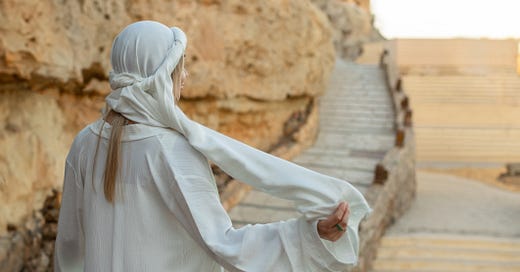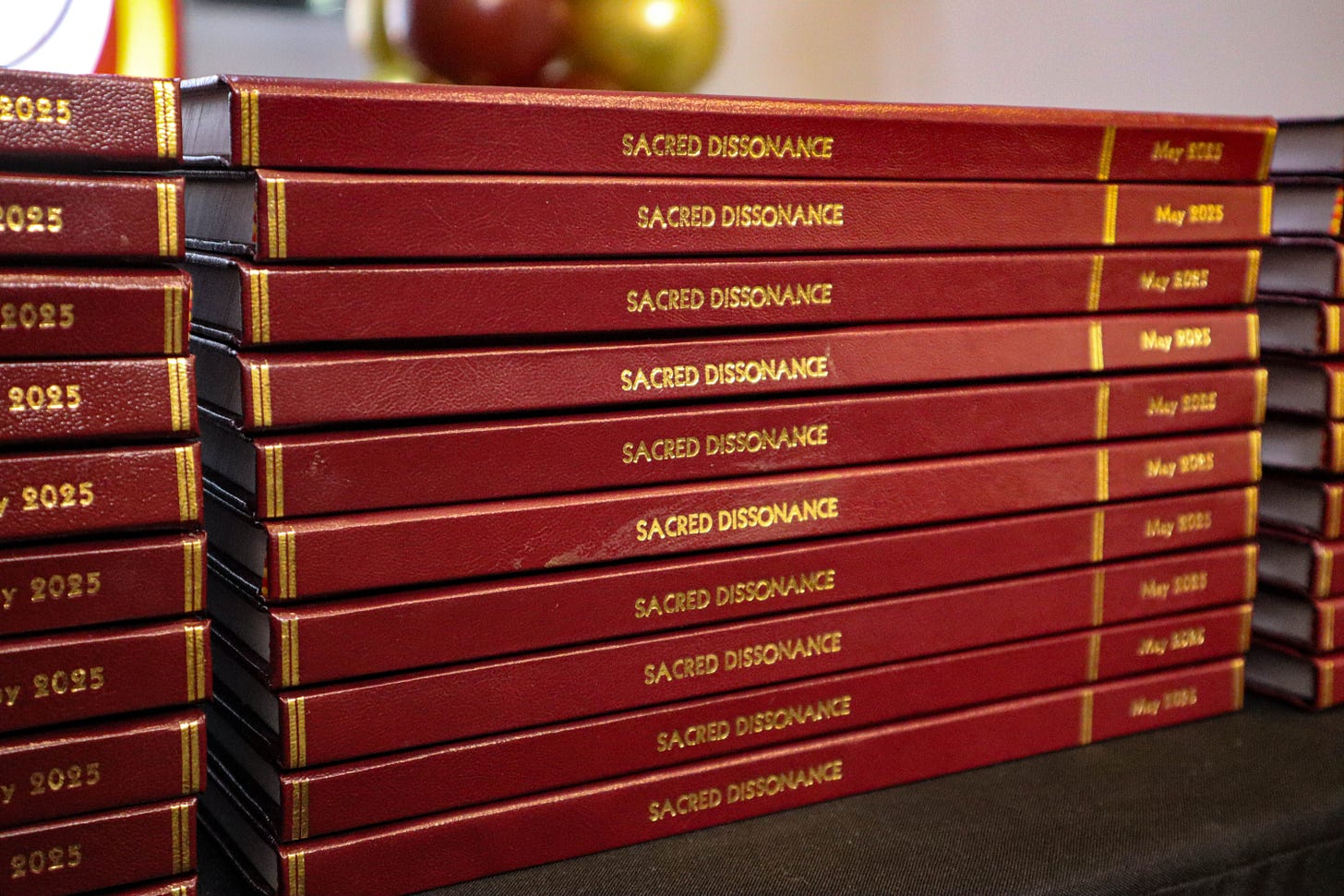The Sacred Art Every Wisdom Tradition Forgot:
How Ancient Masters Used Questions to Awaken Souls
Every spiritual tradition has stories of seekers whose greatest breakthroughs came through wrestling with sacred questions rather than accepting easy answers. Moses at the burning bush. Buddha under the Bodhi tree. Muhammad in the cave. Rumi in his spiritual crisis. What if their confusion and questioning wasn't spiritual failure but the very method that led to their awakening?
The Method Hiding in Plain Sight
Picture this scene from the Gospels: Jesus has just fed five thousand people with a few loaves and fish. The crowd wants to crown him king. Instead, he dismisses everyone and sends his disciples across the sea while he goes up a mountain to pray alone.
Hours later, the disciples are struggling against contrary winds when they see a figure walking on water toward their boat. Their first response? Terror. "It's a ghost!" they cry out. Peter asks to walk on water too, steps out, takes a few steps, then sinks when he focuses on the storm instead of Jesus.
Here's what most sermons miss: This wasn't a failure of faith—it was a designed learning experience. Jesus didn't calm the storm immediately. He didn't prevent Peter's sinking. He let the dissonance play out—the tension between what they thought they knew about reality and what they were actually experiencing.
This same pattern appears across spiritual traditions. The Buddha spent years in extreme asceticism before discovering the Middle Way through engaging rather than avoiding the tension between indulgence and deprivation. Rumi's greatest mystical poetry emerged from the spiritual crisis following his beloved teacher Shams' disappearance. Jewish mystics spoke of the "dark night of the soul" as essential for authentic spiritual development.
Yet modern spiritual communities—whether Christian, Buddhist, Jewish, Muslim, or otherwise—systematically avoid this transformative progression.
The Story All Traditions Tell
When you examine how authentic spiritual awakening actually happened across history and traditions, a universal methodology emerges—one that looks nothing like contemporary religious education or spiritual programming.
Moses encounters a burning bush in the wilderness after forty years of exile. The voice speaking from the flames creates profound dissonance: Return to Egypt as Israel's liberator? Moses has spent decades hiding from his calling. But through wrestling with this impossible summons rather than dismissing it, Moses discovers gifts he never knew he possessed—the ability to carry divine presence so powerfully that his face literally glows after spiritual encounters.
Siddhartha Gautama leaves his palace and encounters suffering, aging, and death for the first time. This creates profound dissonance with his sheltered understanding of existence. Instead of returning to comfort, he engages this tension for years, ultimately awakening as the Buddha through embracing rather than avoiding life's fundamental contradictions.
Muhammad receives his first revelation in a cave on Mount Hira, an experience so disorienting he fears for his sanity. His wife Khadijah and cousin Waraqah, help him understand this dissonance as divine communication rather than mental illness. Through continuing to engage these overwhelming spiritual experiences rather than suppressing them, Muhammad becomes the Prophet of Islam.
Rumi, a respected Islamic scholar, meets the wandering mystic Shams and experiences such profound spiritual disruption that his ordered religious life becomes impossible to maintain. When Shams disappears, Rumi's grief and spiritual searching produce some of history's most powerful mystical poetry, transforming his loss into universal wisdom about divine love.
Rabbi Isaac Luria experiences the destruction of his community and develops Kabbalistic teachings about cosmic repair (tikkun olam) through engaging rather than avoiding the spiritual questions raised by suffering and exile.
The Pattern Mystics Perfected
Across traditions, authentic spiritual teachers used what we might call "sacred questioning" as their primary methodology. Instead of providing immediate answers, they created productive spiritual tension that forced seekers to wrestle with deeper truths.
Jesus told parables that weren't explanations but dissonance generators. The Zen tradition developed koans—spiritual puzzles designed to exhaust rational thinking and open intuitive awareness. Sufi teachers used paradoxical stories and practices to create productive confusion that led to mystical insight. Jewish study methods encouraged questioning and debate as paths to understanding rather than obstacles to overcome.
Consider the famous Zen koan "What is the sound of one hand clapping?" This isn't meant to be solved logically but to create mental tension that eventually opens non-conceptual awareness. Similarly, Jesus' teaching that "whoever wants to save their life will lose it" creates productive dissonance that can't be resolved through ordinary thinking.
The Sufi master Nasruddin stories work the same way—creating spiritual tension through paradox and humor that opens awareness beyond conventional religious thinking. Jewish Talmudic study involves multiple rabbis arguing different interpretations, with the tension between perspectives considered as valuable as any final conclusion.
What We Systematically Eliminated
Ancient wisdom traditions understood that spiritual formation required engaging rather than avoiding sacred questions, growing through tension and breakthrough rather than accumulating information, and building community around shared seeking rather than shared certainty.
But as spiritual traditions became institutionalized, something profound was lost. Picture what happened across cultures: Scripture and sacred texts began to be treated as sources of final answers rather than invitations to deeper questioning. Spiritual leaders became authorities who provided certainty rather than guides who facilitated discovery. Communities formed around agreeing with established teaching rather than supporting each other's authentic spiritual development.
We systematized everything except the system that actually produces spiritual awakening.
The tragic irony spans traditions: we created curricula, programs, classes, and institutions. We developed systematic theologies, apologetics, and doctrinal statements. We built organizations to preserve and transmit spiritual knowledge. But we eliminated the Sacred Dissonance process that wisdom traditions show as the primary method of authentic spiritual formation.
The result? We produce religious practitioners who know about the divine but struggle to encounter it directly. We create believers who can defend their faith but can't navigate spiritual growth. We establish communities that maintain doctrinal purity but lose transformational power.
The Desert Recovery Across Traditions
In various times and places, spiritual seekers have recognized when their traditions became too comfortable, too institutional, too removed from the transformational edge their founders embodied.
Christian Desert Fathers like Anthony of Egypt withdrew to engage spiritual questions directly rather than accepting comfortable institutional answers. They discovered that spiritual maturity came through learning to hold tension rather than eliminating it—understanding that the "dark night of the soul" was often preparation for deeper spiritual awareness.
Buddhist forest monastics throughout history have left comfortable monastery life to practice in wilderness settings where spiritual questions couldn't be avoided through institutional routine. The Thai Forest Tradition, Zen hermit practices, and Tibetan cave yogis all represent recovery of direct spiritual engagement over systematic study.
Jewish mystics developed Kabbalah partly in response to overly rational approaches to spiritual life, creating practices that engaged mystery and paradox as pathways to divine encounter. Hasidic masters like the Baal Shem Tov emphasized joy, storytelling, and direct spiritual experience over purely scholarly approaches.
Sufi orders emerged within Islam to preserve and practice direct spiritual methods that engaged divine love through music, poetry, and ecstatic practices, often in tension with more legalistic approaches to religious life.
But these recoveries often didn't last. As spiritual renewal movements became successful, they typically became systematized again, losing the very edge that made them transformative.
The Learning Process That Actually Worked
Before contemporary spiritual education created membership classes and systematic curricula, authentic spiritual formation across traditions involved extended processes that honored the time transformation requires.
In ancient Jewish tradition, Torah study involved years of questioning, debate, and wrestling with meaning rather than memorizing correct interpretations. Students learned to hold multiple perspectives simultaneously and find wisdom in the tension between different viewpoints.
Buddhist meditation training traditionally involved long periods of practice where confusion, difficulty, and spiritual dryness were considered part of the path rather than problems to solve. Teachers guided students through these challenges rather than trying to eliminate them.
Islamic spiritual education combined Quranic study with mystical practices, poetry, and community life designed to awaken direct spiritual experience rather than just intellectual understanding. Sufi apprenticeship could last decades, with each stage involving deeper engagement with spiritual paradox.
Indigenous wisdom traditions worldwide have always emphasized vision quests, initiation rites, and extended periods of spiritual seeking where discomfort, uncertainty, and direct encounter with mystery are central to authentic development.
The result across traditions was profound: spiritual practitioners who were transformed before becoming teachers, not after. People who had learned to navigate Sacred Dissonance as a way of life, not as something to avoid. Communities built around shared transformation rather than shared beliefs.
The Modern Research That Validates Ancient Wisdom
Contemporary psychology and neuroscience are rediscovering what ancient wisdom traditions always knew. Harvard research on leadership development shows that the most effective leaders can "hold creative tension" rather than rushing to resolve it. Programs that create productive dissonance produce stronger outcomes than those focused on skill acquisition.
Developmental psychology research reveals that authentic maturity requires what researchers call "post-conventional" thinking—the ability to hold paradox, engage complexity, and find meaning beyond simple answers. People who avoid cognitive dissonance remain stuck in conventional stages, never developing the resilience necessary for life's inevitable challenges.
Neuroscience confirms that brain plasticity increases during periods of productive tension. The neural rewiring necessary for transformation happens when we engage rather than avoid challenging questions. Ancient practices like meditation, contemplative prayer, and mystical study create exactly the conditions modern science shows are necessary for consciousness development.
The Choice That Changes Everything
We're living through the largest spiritual awakening in human history—and the largest exodus from institutional religion. These aren't contradictory trends. They're connected.
People are leaving spiritual communities not because they've lost interest in the divine but because they've found Sacred Dissonance and been told it's spiritually dangerous. They're experiencing the same spiritual tension that produced every authentic breakthrough in wisdom tradition history, but instead of being guided through this process, they're being counseled out of it.
Ancient methods offer exactly what contemporary spiritual seekers are looking for: authentic engagement with spiritual reality, permission to wrestle with difficult questions, community that supports transformation rather than conformity, and formation that produces spiritual maturity rather than religious performance.
Spiritual communities implementing Sacred Dissonance methodology across traditions report remarkable transformations. Students trained in these approaches show increased confidence when addressing authentic spiritual questions. Communities practicing Sacred Dissonance principles demonstrate stronger capacity for holding difference and diversity. Young adult retention improves dramatically when questions are welcomed rather than feared.
The Story Your Community Could Tell
Whether you're involved in Christian ministry, Buddhist teaching, Jewish education, Islamic community leadership, or any other spiritual tradition, you've likely experienced Sacred Dissonance about effectiveness. You've wondered why so many people leave after years of faithful participation, why spiritual education often fails to produce transformation, why questions threaten community rather than deepen it.
What if these aren't problems to solve but Sacred Dissonance pointing toward something better? What if your frustration with conventional methods is actually recognition that ancient wisdom is still the most effective approach? What if the questions that make you uncomfortable as a leader are exactly what could transform your community?
The universal pattern of Sacred Dissonance leading to gift awakening and calling fulfillment applies to spiritual leadership as much as individual development. Your leadership dissonance might be calling you toward new capacities for spiritual formation and community building—toward facilitation that actually produces the transformation you entered spiritual service to support.
The Ancient Method for Modern Times
We don't need new methods. We need to recover the ancient approaches that actually work. We don't need to innovate spiritual formation. We need to stop avoiding the universal patterns that wisdom traditions have always demonstrated. We don't need more programs. We need the courage to implement processes that sacred history validates across cultures.
The pattern is simple but profound: create space for Sacred Dissonance rather than eliminating it, guide people through spiritual tension rather than around it, build community that can hold questions alongside insights, and trust that the same process that formed wisdom tradition founders can form contemporary seekers.
This means prayer and meditation become engagement that includes wrestling and questioning alongside peace and clarity. Sacred text study becomes encounter with teachings that challenge and stretch rather than simply confirm existing understanding. Community becomes a laboratory for working through differences rather than a gathering of people who already agree. Leadership becomes guidance through process rather than management of content.
The ancient method is waiting. The question is: Are you ready to let Sacred Dissonance transform your understanding of spiritual formation the way it transformed every wisdom tradition founder who encountered it?
The next time someone in your community experiences spiritual questioning, tension, or disorientation, you'll have a choice. You can treat it as a problem to solve or as a sacred invitation to guide them through the same formation process that shaped Buddha, Moses, Muhammad, Rumi, and countless others throughout history.
The ancient method never stopped working. We just stopped using it.
What has been your experience with Sacred Dissonance in spiritual community? Have you noticed the universal pattern of confusion leading to breakthrough in your own development or in those you serve? How might recovering ancient methodology transform contemporary spiritual formation across traditions?
Ready to explore your own Sacred Dissonance journey? Take the Sacred Dissonance Quiz to discover which of the 12 universal spiritual journey types most closely matches your experience and calling.
Want to go deeper into ancient wisdom? The Sacred Dissonance Book provides a complete exploration of all 12 spiritual journeys and the universal foundation for this transformative framework.
For spiritual leaders: Ready to implement universal formation methodology in your context? Experience ancient wisdom firsthand through The Sacred Sanctuary Getaway: THE GIFT AWAKENING™ EXPERIENCE—where you'll learn to guide Sacred Dissonance rather than suppress it.
For spiritual seekers: If conventional religious education hasn't produced the transformation you're seeking, discover how ancient methods might be exactly what your soul has been looking for. Start your journey at https://www.mastercoacha.com where you'll find resources for experiencing the universal patterns that formed wisdom tradition founders.







This made me appreciate more our profession. At the heart of life coaching is not advice—but questions. Questions that allow a person to pause, reflect, and align deeply within and discover oneself, which is the beginning of the transformation.
This is the sacred work we do—not giving answers, but making room for them to arise from within. Thank you Master Coach A!!
Communities practicing Sacred Dissonance principles demonstrate stronger capacity for holding difference and diversity. Young adult retention improves dramatically when questions are welcomed rather than feared. #PackMyBagMoment I can relate to this when I had this moment of asking questions to elders/pioneers in a certain community, when I received a comment from them saying "Bata ka pa to ask questions sa amin na mas nangunguna sa'yo" that is why I do believe it is one of the reasons where there is no retention.